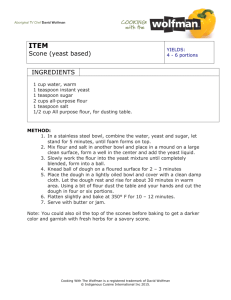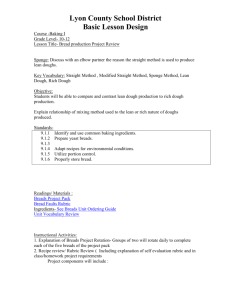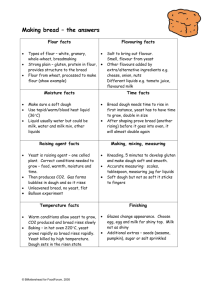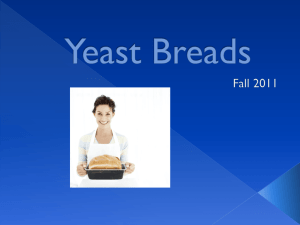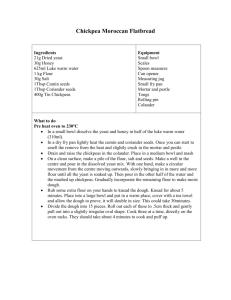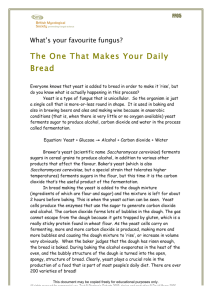Yeast dough and bread production
advertisement
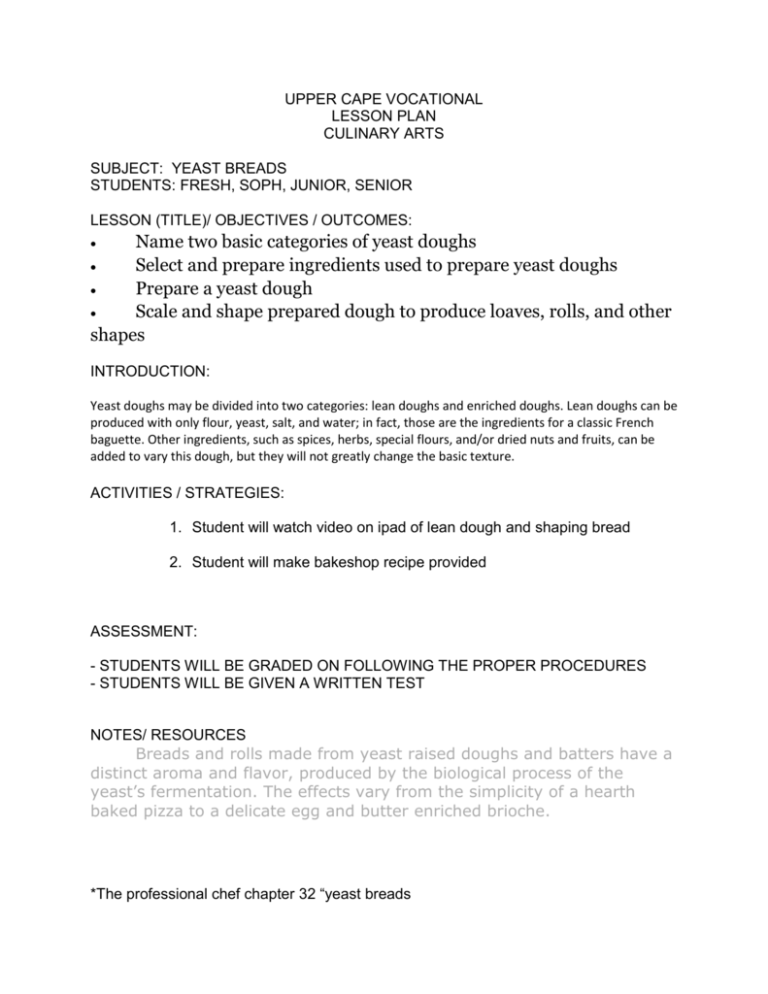
UPPER CAPE VOCATIONAL LESSON PLAN CULINARY ARTS SUBJECT: YEAST BREADS STUDENTS: FRESH, SOPH, JUNIOR, SENIOR LESSON (TITLE)/ OBJECTIVES / OUTCOMES: Name two basic categories of yeast doughs Select and prepare ingredients used to prepare yeast doughs Prepare a yeast dough Scale and shape prepared dough to produce loaves, rolls, and other shapes INTRODUCTION: Yeast doughs may be divided into two categories: lean doughs and enriched doughs. Lean doughs can be produced with only flour, yeast, salt, and water; in fact, those are the ingredients for a classic French baguette. Other ingredients, such as spices, herbs, special flours, and/or dried nuts and fruits, can be added to vary this dough, but they will not greatly change the basic texture. ACTIVITIES / STRATEGIES: 1. Student will watch video on ipad of lean dough and shaping bread 2. Student will make bakeshop recipe provided ASSESSMENT: - STUDENTS WILL BE GRADED ON FOLLOWING THE PROPER PROCEDURES - STUDENTS WILL BE GIVEN A WRITTEN TEST NOTES/ RESOURCES Breads and rolls made from yeast raised doughs and batters have a distinct aroma and flavor, produced by the biological process of the yeast’s fermentation. The effects vary from the simplicity of a hearth baked pizza to a delicate egg and butter enriched brioche. *The professional chef chapter 32 “yeast breads lean and enriched doughs Lean doughs contain only relatively small amounts of sugar and fat, if any. Breads made from lean dough tend to have a chewier texture, more bite, and a crisp crust. Types: Hard rolls, French and Italian-style breads, and whole wheat, rye, and pumpernickel breads are considered lean. BAKING THE BREAD : Lean doughs should be baked in a hot oven (400° to 450°F/204° to 232°C) with steam Enriched doughs are produced by the addition of ingredients such as sugar or syrup, butter or oil, whole eggs or egg yolks, and milk or cream. Types: soft rolls, brioche, and challah. BAKING THE BREAD: enriched doughs should be baked at a slightly lower temperature (approximately 375°F/191°C) washes Use beaten eggs as a wash to create a glossy, shiny crust and seal in the moisture in the bread. Milk or cream is often used for breads baked at lower temperatures. garnishing Garnishing the top of loaves or rolls adds flavor as well as appeal. Herbs, salt, olives, and seeds as well as flours such as semolina or rye may be applied after shaping, but before the final fermentation. Use a bit of water on the surface to adhere the garnish if the dough is not moist enough on its own to make it stick. Wheat flour (all-purpose or bread flour, for instance) is the basis of yeast-raised doughs. Wheat flours contain a high percentage of protein, which gives a good texture to lean doughs. A portion of the wheat flour called for in a recipe may be replaced with other flours such as rye, pumpernickel, or oat. Yeast is a biological leavener that must be alive in order to be effective. Bring the yeast to room temperature if necessary before preparing the dough. Water, milk, or other liquids used in a bread formula should fall within a temperature range of 68° to 76°F/20° to 24°C for compressed (fresh) yeast. The ideal water temperature for instant dry yeast is 105° to 110°F/41° to 43°C. The viability of yeast may be tested by proofing. To do so, combine the yeast with warm liquid and a small amount of flour or sugar. Let the mixture rest at room temperature until a thick surface foam forms. The foam indicates that the yeast is alive and can be used. If there is no foam, the yeast is dead and should be discarded. Salt develops flavor in bread and also helps to control the action of the yeast. If salt is omitted, breads do not develop as good a flavor or texture. Pan preparation depends on the type of dough to be baked. Because of their higher browning point, lean doughs should be baked directly on the hearth. If this is not possible, either line the pan with parchment paper or dust it with cornmeal or semolina flour; cornmeal is especially well suited to free-form loaves such as baguettes or round loaves. For doughs with a higher percentage of milk, sugar, and fat, grease the pan or line it with parchment paper. The simplest and fastest method for producing a lean dough is direct fermentation: Commercially produced yeast is combined with flour, water, and salt and mixed until the dough is supple and elastic, with well-developed gluten. The straight mixing method is most often used with formulas that rely on direct fermentation. For this mixing method, the ingredients are added in a different order depending on the type of yeast used. If instant dry yeast is used, the yeast should first be blended with the flour, then all the remaining ingredients should be added to the flour-yeast mixture. If active dry or compressed fresh yeast is used, the yeast should first be blended with the water and allowed to fully dissolve. Next the flour should be added and all the remaining ingredients should be placed on top of the flour.
